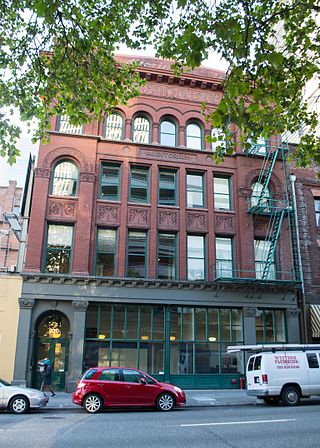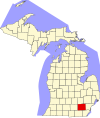
The Michigan Theater is a movie palace in Ann Arbor, Michigan, United States, near the Central Campus of the University of Michigan. It shows independent films and stage productions, and hosts musical concerts.
The Penobscot Building Annex is a 23-story, 94.49 m (310.0 ft) office skyscraper located at 144 West Congress Street in Downtown Detroit, Michigan. This portion of the Penobscot Block is now physically connected to the newer Penobscot Building Tower.

The Vinton Building is a residential high-rise located at 600 Woodward Avenue in Downtown Detroit, Michigan. It stands next to the First National Building, across Woodward Avenue from Chase Tower and the Guardian Building, and across Congress Street from One Detroit Center. It was designated a Michigan State Historic Site in 1982 and listed on the National Register of Historic Places in 1983.

The Lawyers Building is an office building located at 137 Cadillac Square in downtown Detroit, Michigan. It was also known as the American Title Building. The building was listed on the National Register of Historic Places in 1982.

The Pioneer Building is a Richardsonian Romanesque stone, red brick, terra cotta, and cast iron building located on the northeast corner of First Avenue and James Street, in Seattle's Pioneer Square District. Completed in 1892, the Pioneer Building was designed by architect Elmer Fisher, who designed several of the historic district's new buildings following the Great Seattle Fire of 1889.

The Bankers Trust Company Building is an office building located at 205 West Congress Street in Downtown Detroit, Michigan, within the Financial District. Designed by Wirt C. Rowland of Smith, Hinchman & Grylls and completed in 1925 the ornately modeled building is an exquisite example of Italian Romanesque Revival architecture.

The Barnes and Thornburg Building is a high rise in Indianapolis, Indiana originally known as the Merchants National Bank Building. In 1905, the Merchants National Bank and Trust Company engaged the architectural firm of D. H. Burnham & Company of Chicago to design a new bank headquarters on the southeastern corner of the Washington and Meridian streets, the most important intersection in Indianapolis. Initial occupancy of the lower floors took place in 1908, while the upper floors were not completed until 1912.

The Levi Heywood Memorial Library Building is an historic library building at 28 Pearl Street in Gardner, Massachusetts. Completed in 1886, it is one of the city's most architecturally distinguished buildings, and a good example of Richardsonian Romanesque design. It was given in honor of Levi Heywood, a prominent figure in the city's economically important chair manufacturing industry. It was used as a library until 1978, and now houses a museum dedicated to the city's history. The building was listed on the National Register of Historic Places in 1979, and included in the Gardner Uptown Historic District in 1999.

The Unitarian Universalist Church is a historic church building at 100 N. State Street in Ann Arbor, Michigan. It was listed on the National Register of Historic Places in 1978.

The Tuomy Hills Service Station is a commercial building located 2460 Washtenaw Avenue in Ann Arbor, Michigan. It was listed on the National Register of Historic Places in 2000.

The Auditorium and Music Hall is a historic building in Portland, Oregon, in the United States, designed by English architect Frederick Manson White. It was built by Emil C. Jorgensen and was completed in 1895. The building is listed on the National Register of Historic Places (NRHP).

St. Thomas the Apostle Catholic Church is a parish of the Roman Catholic Church located in Ann Arbor, Michigan at 530-540 Elizabeth Street. Its historic parish church is listed as a Michigan State Historic Site.

The Ann Arbor station is a former Michigan Central Railroad station located at 401 Depot Street in Ann Arbor, Michigan. It was converted into a restaurant, the Gandy Dancer, in 1970, and listed on the National Register of Historic Places as Michigan Central Railroad Depot in 1975.

The Washtenaw County Administration Building is a former post office located at 220 North Main Street in Ann Arbor, Michigan. The building is now owned by Washtenaw County, Michigan. It was listed on the National Register of Historic Places in 1978.

The University of Michigan Central Campus Historic District is a historic district consisting of a group of major buildings on the campus of the University of Michigan in Ann Arbor, Michigan. It was listed on the National Register of Historic Places in 1978.

The Northern Brewery is a former industrial building located at 1327 Jones Drive in Ann Arbor, Michigan. It was listed on the National Register of Historic Places in 1979.

Harris Hall is an auditorium located at 617 East Huron Street in Ann Arbor, Michigan. It was listed on the National Register of Historic Places in 1982.

The William Anderson House is a single-family house located at 2301 Packard Street in Ann Arbor, Michigan. It was listed on the National Register of Historic Places in 1983. Built around 1853 for William Anderson, the first Washtenaw County Sheriff, the house is a well-preserved surviving example of Greek Revival architecture in Southeast Michigan. The house is owned by Genesis of Ann Arbor, a joint Jewish-Christian house of worship that has used the Anderson House for its food bank program since 2007.

Nickels Arcade is a commercial building located at 326-330 South State Street in Ann Arbor, Michigan. It was listed on the National Register of Historic Places in 1987. The building is notable as perhaps the only remaining example in Michigan of a free-standing commercial arcade building of a type that was popularized by the Cleveland Arcade.

The Michigan Trust Company Building, also known as the Michigan Trust Building or just the Trust Building, is an office building located at 40 Pearl Street NW in Grand Rapids, Michigan. It was listed on the National Register of Historic Places in 1983.
























